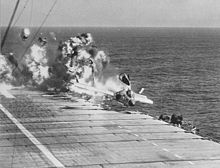
The Battle of Midway was a major naval battle in the Pacific Theater of World War II that took place on 4–7 June 1942, six months after Japan's attack on Pearl Harbor and one month after the Battle of the Coral Sea. The Japanese Combined Fleet under the command of Isoroku Yamamoto suffered a decisive defeat by the U.S. Pacific Fleet near Midway Atoll, about 1,300 mi northwest of Oahu. Yamamoto had intended to capture Midway and lure out and destroy the Pacific Fleet, especially the U.S. aircraft carriers which had escaped damage at Pearl Harbor.

Hiryū was an aircraft carrier built for the Imperial Japanese Navy (IJN) during the 1930s. Generally regarded as the only ship of her class, she was built to a modified Sōryū design. Her aircraft supported the Japanese invasion of French Indochina in mid-1940. She took part in the attack on Pearl Harbor and the Battle of Wake Island. During the first few months of the Pacific War, the ship supported the conquest of the Dutch East Indies in January 1942. The following month, her aircraft bombed Darwin, Australia; and continued to assist in the Dutch East Indies campaign. In April, Hiryū's aircraft helped sink two British heavy cruisers and several merchant ships during the Indian Ocean Raid.

Kaga was an aircraft carrier built for the Imperial Japanese Navy (IJN). Originally intended to be one of two Tosa-class battleships, Kaga was converted under the terms of the Washington Naval Treaty to an aircraft carrier as the replacement for the battlecruiser Amagi, which had been irreparably damaged during the 1923 Great Kantō earthquake. Kaga was rebuilt in 1933–1935, increasing her top speed, improving her exhaust systems, and adapting her flight decks to accommodate more modern, heavier aircraft.
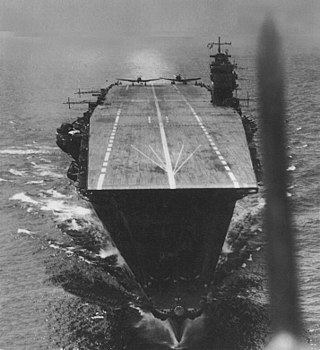
Akagi was an aircraft carrier built for the Imperial Japanese Navy (IJN). Though she was laid down as an Amagi-class battlecruiser, Akagi was converted to an aircraft carrier while still under construction to comply with the terms of the Washington Naval Treaty. The ship was rebuilt from 1935 to 1938 with her original three flight decks consolidated into a single enlarged flight deck and an island superstructure. The second Japanese aircraft carrier to enter service, and the first large or "fleet" carrier, Akagi and the related Kaga figured prominently in the development of the IJN's new carrier striking force doctrine that grouped carriers together, concentrating their air power. This doctrine enabled Japan to attain its strategic goals during the early stages of the Pacific War from December 1941 until mid-1942.

USS Yorktown (CV-5) was an aircraft carrier that served in the United States Navy during World War II. Named after the Battle of Yorktown in 1781, she was commissioned in 1937. Yorktown was the lead ship of the Yorktown class, which was designed on the basis of lessons learned from operations with the converted battlecruisers of the Lexington class and the smaller purpose-built USS Ranger.

USS Hornet (CV-8), the seventh U.S. Navy vessel of that name, was a Yorktown-class aircraft carrier of the United States Navy.
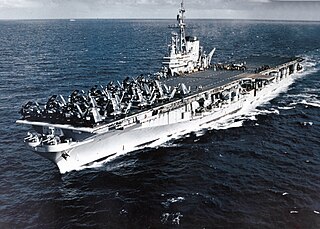
USS Midway (CVB/CVA/CV-41) is an aircraft carrier, formerly of the United States Navy, the lead ship of her class. Commissioned eight days after the end of World War II, Midway was the largest warship in the world until 1955, as well as the first U.S. aircraft carrier too big to transit the Panama Canal. She operated for 47 years, during which time she saw action in the Vietnam War and served as the Persian Gulf flagship in 1991's Operation Desert Storm. Decommissioned in 1992, she is now a museum ship at the USS Midway Museum, in San Diego, California, and is the only remaining inactive U.S. aircraft carrier that is not an Essex-class aircraft carrier.

The flight deck of an aircraft carrier is the surface from which its aircraft take off and land, essentially a miniature airfield at sea. On smaller naval ships which do not have aviation as a primary mission, the landing area for helicopters and other VTOL aircraft is also referred to as the flight deck. The official U.S. Navy term for these vessels is "air-capable ships".

The Grumman F9F Panther is an early carrier-based jet fighter designed and produced by the American aircraft manufacturer Grumman. It was the first jet-powered fighter aircraft to see air-to-air combat with the United States Navy as well as being Grumman’s first jet fighter.

The Battle of the Santa Cruz Islands, fought during 25–27 October 1942, sometimes referred to as the Battle of Santa Cruz or Third Battle of Solomon Sea, in Japan as the Battle of the South Pacific, was the fourth aircraft carrier battle of the Pacific campaign of World War II. It was also the fourth major naval engagement fought between the United States Navy and the Imperial Japanese Navy during the lengthy and strategically important Guadalcanal campaign. As in the battles of the Coral Sea, Midway, and the Eastern Solomons, the ships of the two adversaries were rarely in sight or gun range of each other. Instead, almost all attacks by both sides were mounted by carrier- or land-based aircraft.
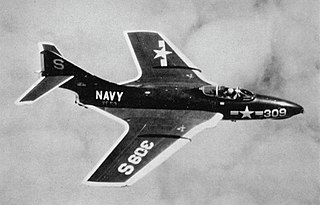
The Grumman F9F/F-9 Cougar is a carrier-based jet-powered fighter aircraft designed and produced by the American aircraft manufacturer Grumman.

Naval aviation / Aeronaval is the application of military air power by navies, whether from warships that embark aircraft, or land bases. It often involves navalised aircraft, specifically designed for naval use. Seaborne aviation encompasses similar activities not restricted to navies, including marines and coast guards, such as in U.S. naval aviators.

Midway, released in the United Kingdom as Battle of Midway, is a 1976 American war film that chronicles the Battle of Midway, a turning point in the Pacific Theater of Operations of World War II. Directed by Jack Smight and produced by Walter Mirisch from a screenplay by Donald S. Sanford, the film starred Charlton Heston and Henry Fonda, supported by a large international cast of guest stars including James Coburn, Glenn Ford, Ed Nelson, Hal Holbrook, Robert Webber, Toshiro Mifune, Robert Mitchum, Cliff Robertson, Robert Wagner, Pat Morita, Dabney Coleman, Erik Estrada and Tom Selleck.

Jun'yō was a Hiyō-class aircraft carrier of the Imperial Japanese Navy (IJN). She was laid down as the passenger liner Kashiwara Maru (橿原丸), but was purchased by the IJN in 1941 while still under construction and converted into an aircraft carrier. Completed in May 1942, the ship participated in the Aleutian Islands Campaign the following month and in several battles during the Guadalcanal Campaign later in the year. Her aircraft were used from land bases during several battles in the New Guinea and Solomon Islands Campaigns.

Carrier Air Wing Five (CVW-5) is a United States Navy aircraft carrier air wing based at Marine Corps Air Station Iwakuni. The air wing is attached to the aircraft carrier USS George Washington. It was initially formed in 1943. It has participated in the Second World War, the Korean War, the Gulf War, Operation Southern Watch, the War in Afghanistan, and the War in Iraq.
An armoured flight deck is an aircraft carrier flight deck that incorporates substantial armour in its design.
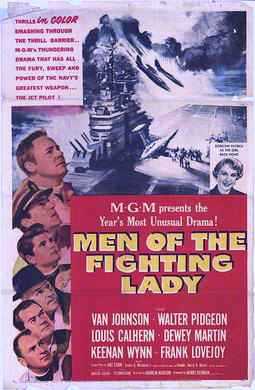
Men of the Fighting Lady is a 1954 American war drama film directed by Andrew Marton and starring Van Johnson, Walter Pidgeon, Louis Calhern and Keenan Wynn. The screenplay was written by U.S. Navy Commander Harry A. Burns, who had written a Saturday Evening Post article, "The Case of the Blinded Pilot", an account of a U.S. Navy pilot in the Korean War, who saves a blinded Navy pilot by talking him down to a successful landing. Men of the Fighting Lady was also inspired by another Saturday Evening Post article, "The Forgotten Heroes of Korea" by James A. Michener. The original music score was composed by Miklós Rózsa. It is also known as Panther Squadron. It is not to be confused with the 1944 documentary The Fighting Lady, which was mainly filmed aboard the USS Yorktown (CV-10).

Lawrence Cleveland "Larry" Chambers is the first African American to command a U.S. Navy aircraft carrier and the first African-American graduate of the Naval Academy to reach flag rank. While in command of USS Midway during Operation Frequent Wind, Chambers gave the controversial order to push overboard millions of dollars' worth of UH-1 Huey helicopters so Republic of Vietnam Air Force Major Buang-Ly could land on the aircraft carrier in a Cessna O-1 Bird Dog with his wife and five children, thereby saving their lives.
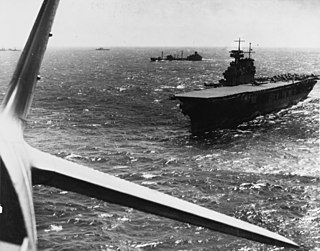
Aircraft carrier air operations include a launch and recovery cycle of embarked aircraft. Launch and recovery cycles are scheduled to support efficient use of naval aircraft for searching, defensive patrols, and offensive airstrikes. The relative importance of these three missions varies with time and location. Through the first quarter-century of aircraft carrier operations, launch and recovery cycles attempted to optimize mission performance for ships with a straight flight deck above an aircraft storage hangar deck. Carrier air operations evolved rapidly from experimental ships of the early 1920s through the combat experience of World War II.
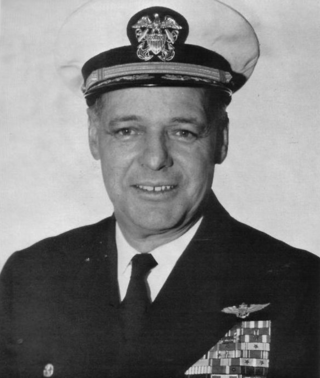
George Chamberlain Duncan was a highly decorated United States Navy officer, World War Two veteran and flying ace. Born in Tacoma, Washington, he was credited with destroying 13+1⁄2 enemy aircraft and was awarded the Navy Cross during World War II.
